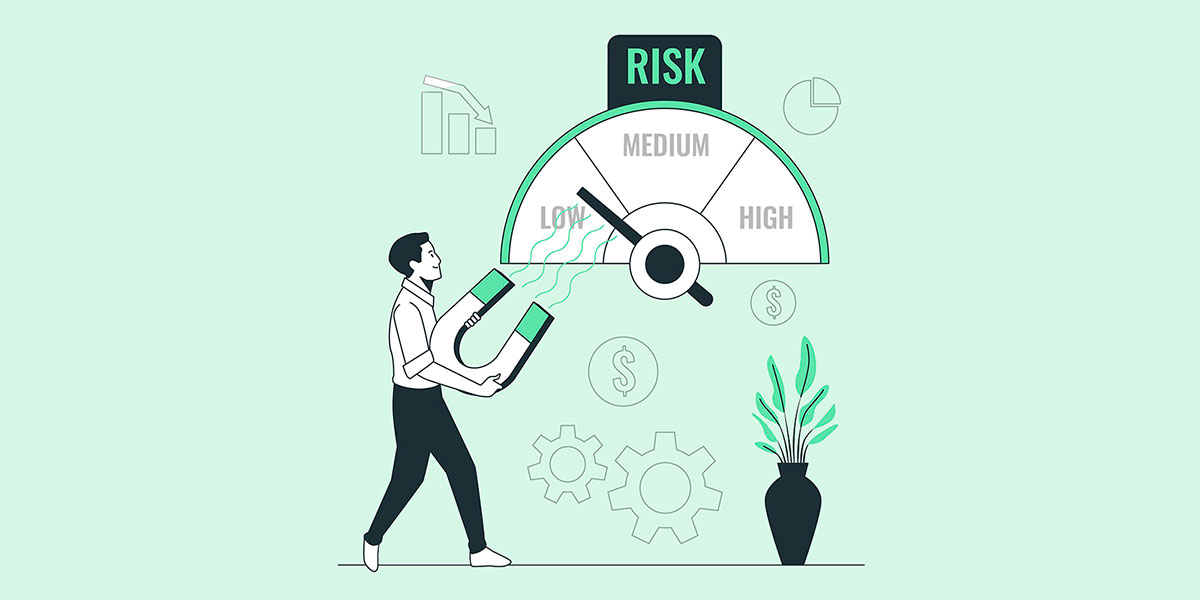Ever pause to think about the concept of risk in our everyday lives? It’s like the uninvited guest at the party, always there, but nobody really wants to acknowledge it. But here’s the deal: it doesn’t have to be a party pooper.
With a well-oiled risk management process, we can not only acknowledge the risk, but also manage it effectively, turning potential pitfalls into opportunities.
Sounds cool, right?
Comprehending the Intricacies of Risk
Risk, oh risk! In our personal life, it might be as simple as deciding whether to take an umbrella on a cloudy day.
But when it comes to business, it’s a whole different ball game.
Risk in business isn’t just about weather—it’s about markets, the environment, finance, operations, and a whole lot more.
The Many Faces of Risk
Now, when we say risk, it’s not a one-size-fits-all kind of deal. There are several types to look out for:
Market risk: The ever-changing dynamics of the market can impact businesses. For example, competitor activities, changing customer preferences, or new regulations can all add to this risk.
Environmental risk: These are risks arising from the physical world. Think natural disasters or a global pandemic disrupting business operations.
Financial risk: Money makes the world go round, and businesses are no exception. Financial risks can come from factors like currency exchange rates, interest rates, or credit issues.
Operational risk: This is all about the nitty-gritty of running a business. Think risks related to IT systems, processes, or even people.
Each of these risks is like a piece of a puzzle that can affect the whole picture—our business.
Risk – The Good and The Bad
Risk doesn’t always spell trouble. It’s a bit like a coin, with both a positive and negative side.
Negative risks are what we usually think of when we hear the word “risk”. These are potential events that could cause a loss or damage. For example, a sudden drop in market demand for a product is a negative risk.
On the flip side, we have positive risks or opportunities. These are unexpected events that can benefit the business. An unexpected market trend that boosts demand for your product? That’s a positive risk.
So, there we have it—the world of risk in a nutshell. In the next section, we’ll talk about how to navigate this world with our trusty compass—the risk management process.
The risk management process is a structured approach to deal with risk effectively. It’s not just about dealing with problems as they come. It’s about proactively identifying and managing risks, transforming uncertainties into confidence. It’s the business equivalent of turning lemons into lemonade!
The Odyssey of Risk Management Process
It’s time to talk about our lifeboat in the choppy waters of business risks – the risk management process. It’s like a detailed map guiding us through the labyrinth of potential risks.
Spotting the Risks – Risk Identification
So, the first stop on our journey is risk identification. Imagine trying to dodge invisible obstacles. Sounds tricky, right? It’s the same with risks – if we don’t see them, we can’t dodge them. Risk identification is about bringing these hidden risks into the light.
Risk identification isn’t just a one-off task, it’s ongoing. The world keeps changing and so do the risks we need to keep an eye out for.
So how do we spot these risks?
One way is through brainstorming sessions with our team – different perspectives can help bring different risks into focus. Other techniques include analyzing past data and using industry insights.
Once we’ve identified the risks, we make a list – a risk register. This is like our guidebook for risks, providing all the details we need about each risk, such as their potential impact and likelihood.
Evaluating the Risks – Risk Assessment
With our risks identified, the next step in the risk management process is to assess them. Just like not all superheroes wear capes, not all risks carry the same weight. Risk assessment helps us figure out which risks are real biggies and which ones, well, not so much.
There are two ways we typically assess risks – qualitative risk assessment and quantitative risk assessment.
Qualitative risk assessment is all about using our judgment to rank risks based on their potential impact and likelihood, without relying on numbers. Think of it like a color-coded system, with red for high-risk, orange for medium-risk, and green for low-risk.
Quantitative risk assessment, on the other hand, is all about the numbers. Here, we use statistical techniques to give a numerical value to the risk. It’s like attaching a price tag to each risk.
Prioritizing the Risks – Risk Prioritization
Once we’ve assessed our risks, the next step is to prioritize them. This is where we put on our sorting hats and decide which risks need our immediate attention and which ones can wait.
The risk ranking helps us allocate our resources effectively and focus on the most critical risks first.
Prioritizing risks isn’t just about the potential impact, we also consider how likely they are to happen.
Managing the Risks – Risk Mitigation
Now that we’ve sorted our risks, it’s time to get down to business and deal with them. This is where risk mitigation comes in. We have four strategies at our disposal here:
Acceptance: Sometimes, the cost of managing a risk may outweigh the potential loss. In such cases, we might choose to accept the risk.
Avoidance: If a risk poses a severe threat, we might decide to avoid it entirely, perhaps by not engaging in the risky activity.
Control/Mitigation: This is about taking steps to reduce the impact or likelihood of the risk.
Transfer: This involves shifting the risk to another party, like insurance.
Our action plan for dealing with the risks is known as the risk mitigation plan.
Digital Allies in Risk Management
Alright, moving on. Did you know we’ve got an ace up our sleeves when dealing with risks? Technology. Yes, you heard it right!
Risk Management Software – The Digital Sidekick
Risk management software. Doesn’t that sound like a superhero straight out of a comic book? It’s a tool designed to make our risk management process easier and more efficient. Imagine having a digital sidekick that can help you identify, assess, and monitor risks.
The benefits? Well, it offers a centralized system to record and track risks. No more sifting through stacks of paper or numerous spreadsheets. It also provides real-time updates and alerts for risks, helping you stay on top of things.
But before you rush to get one, there are some features you might want to look out for, like customizable risk assessment criteria, integration capabilities with other software, easy-to-understand dashboards, and robust reporting features.
And hey, technology doesn’t have to be complex or costly. There are free tools out there that can help in visualizing and understanding data, like heatmap tools.
Building a Risk-Aware Culture
No matter how many tools we have or how robust our risk management process is, if the people in our organization don’t understand or value risk management, it’s all for naught.
This is where building a risk-aware culture comes in.
The Power of Awareness and Training
Think of it as creating an environment where everyone is a risk manager in their own right. Sounds cool, doesn’t it? It’s about making risk management a part of the DNA of our organization, where everyone is aware of the risks and knows what to do about them.
This involves training our team on the basics of risk management, like how to identify and report risks. It also includes providing them with the tools they need to manage risks effectively.
But it’s not just about training, it’s also about communication. Open dialogue about risks encourages everyone to be proactive in identifying and managing them.
FAQs About The Risk Management Process
Why Bother with Risk Management?
Life’s a gamble. You never know what’s coming. Similarly, in any project or business, unexpected situations can pop up. Risk management is your safety net. It helps you identify possible issues before they become real problems. It’s like having a roadmap for all the pitfalls on your journey.
What Are the Steps in Risk Management?
Think about risk management as a recipe. It’s a step-by-step process. First, identify potential risks. Then, evaluate how likely they are to happen and what impact they would have. After that, plan how to avoid or reduce those risks. Finally, keep monitoring and adjusting your plans as needed. It’s a continuous, evolving process.
What Exactly is Risk Identification?
Spotting a risk is the first step. It’s about brainstorming all possible issues that could derail your project. It could be anything from a sudden cost increase to a critical team member falling ill. No risk is too big or too small to consider. This stage requires creativity and foresight.
How Do We Evaluate Risks?
Think of risk evaluation as the process of rating a movie. Each risk gets scored based on how likely it is to occur and the impact it would have. This step helps prioritize risks and decide which ones need immediate attention. It’s a balancing act.
What’s a Risk Mitigation Strategy?
Mitigating a risk means reducing its potential impact or the chance it will occur. It’s like carrying an umbrella on a cloudy day. You’re preparing for the possibility of rain. Mitigation strategies can range from getting insurance to cross-training your team to cover all roles.
Is Risk Management Only About Negative Events?
Risk management isn’t just about planning for disasters. It also involves spotting opportunities. A good risk might be a new market trend that you could capitalize on before your competitors do. It’s about taking calculated risks for greater rewards.
Why Is Risk Monitoring Important?
Monitoring risks is like keeping an eye on a pot of soup. You don’t want it to boil over. Similarly, you want to keep track of how your risks are changing and if your strategies are working. This step helps you adjust your plans and respond quickly to any changes.
What’s the Role of Communication in Risk Management?
In risk management, communication is as important as the steps themselves. Everyone on the team should understand the risks and the plans to deal with them. It’s like everyone knowing the game plan in a football match. Strong communication helps everyone react effectively when risks arise.
How Does Technology Aid Risk Management?
Technology in risk management is like a Swiss Army knife. It provides various tools to identify, evaluate, and manage risks effectively. From predictive analytics to automated reporting, technology streamlines the process and provides insightful data.
Can We Ever Eliminate All Risks?
Unfortunately, eliminating all risks is impossible. It’s like trying to predict every twist and turn of a roller coaster ride. But good risk management helps you prepare for the ride and enjoy it without fear of the unexpected.
Ending Thoughts on The Risk Management Process
So there we have it, the end of our journey through the world of risk management. To recap, the risk management process is like a roadmap guiding us through the jungle of business risks, helping us navigate from identifying risks to mitigating them.
With the help of technology, we can manage risks more efficiently. And by building a risk-aware culture, we can ensure that risk management isn’t just a process, but a way of life in our organization.
Implementing these strategies may seem like a daunting task, but trust me, it’s worth it. In the unpredictable world of business, managing risks can be the difference between success and failure.
If you enjoyed reading this article on the risk management process, you should check out this one about startup failure.
We also wrote about a few related subjects like best startup books, gifting shares, London startups, share options, types of investors, Berlin startups, startup press kit examples, startup advice, startup consultants, financial projections for startups, and failed startups.
- Design’s Descent: What Happened to Fab? - April 19, 2024
- Design Basics: iPhone App Icon Size Requirements - April 19, 2024
- Quick Guide For Developing Mobile Games - April 18, 2024








